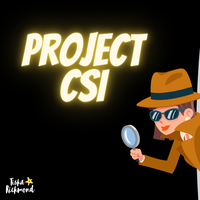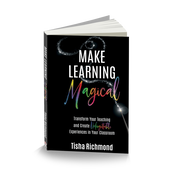Project csi: reality game show inspired activities to bring mystery and the 4 C's into learning8/8/2021 
Scooby Doo, Nancy Drew, Miami Device….I’ve always loved a good mystery and found such satisfaction in solving the clues before it is revealed. Solving a mystery requires many important skills that belong in learning and I love finding ways to bring those skills into the classroom. When I heard about the new reality television game show, Crime Scene Kitchen, I knew an afternoon of binge watching was just the inspiration I needed to whip up some new ways to bring mystery into learning.
In Crime Scene Kitchen, six teams of two bakers/detectives are given one verbal hint and 3 minutes each to rotate through a kitchen sprinkled with evidence that leads to a mystery recipe. For example, the clues that led to a Black Forest Cake was: pastry cream in the sink, a cake tin on the drying rack, melted chocolate, circle of almonds on parchment, toothpick dipped in chocolate, and a bottle of Kirsch. There were also some false leads like an unopened carton of raspberries, and unused pie tins still in the wrapper.
Following their investigation, they are given 2 hours to create the dessert they think the evidence is leading to. The team that both recreates the correct mystery recipe with the highest degree of accuracy, determined by the judges, gets a bonus clue for a similar second elimination round where they create a showcase dessert.
As I watch, so many common elements among other shows surface that would benefit classroom learning. Investigating the crime scene requires communicating, questioning, and critically thinking about the evidence to determine the mystery recipe. The contestants are questioning and talking through to interpret what the clues mean and the recipes that they lead to. Sometimes there is instant agreement, other times disagreement or compromise. They are critically thinking as they piece the clues together to determine what recipe they will recreate. This requires tapping into prior knowledge, and quite possibly, are behind the scenes doing a little research.
Once the investigation is complete contestants begin replicating the mystery recipe based on their hypothesis. In order to prepare the dessert within the given time frame requires a large serving of communication, collaboration, and creativity. Teams must be efficient, fluid, calm, and kind. Disagreements and disorganization only lead to frustration and failure to complete the recipe before the time runs out. It also requires prior knowledge and skill to be able to demonstrate the methods and skills needed to prepare the recipe accurately.
So, how does this transfer to classroom learning? I’m going to share some activities that I have created from the show’s inspiration that would work in the middle or high school culinary classroom. Not a culinary arts teacher? Or, teaching remote this year? I’ve been thinking about you too! Scroll past the Crime Scene Kitchen and Mystery Recipe Dash activities to find possible variations for numerous subject areas and grade levels and remote learning! I also added a Padlet that is embedded at the bottom of this post for us to brainstorm and share our ideas with each other.
Crime Scene Kitchen - Classroom Edition
This version is broken into four phases , so may need to be broken into two days unless you have a 2 hour block period.
Mystery Recipe:
Select a mystery recipe you’d like students to learn about through discovery. It is best if they have already had opportunities to learn the skills and methods needed to prepare the recipe.
Stage the Crime Scene:
The crime scene can be staged in a few different ways. Option 1: Stage a table or area in the classroom with approximately 6 clues that lead to the mystery recipe. Add a few false leads to add another level of complexity. Option 2: Prepare visual clues that can be placed in a manila folder to hand to each group.
The Hook:
As students enter have dramatic theme music playing and a graphic displayed on the screen that says "Crime Scene Kitchen". Hand out rubber gloves for them to wear while in the crime scene. You could also dress up as a private investigator to create another element to draw students into the activity.
Crime Scene
Divide students into teams of 3-5. It could be their regular kitchen teams, or you could divide them up differently for this activity. Share the story line and explain the activity. If using option 1, remove the caution tape and covering from crime scene and let each group in for 3 minutes at a time to investigate. Make sure they bring something to write with to record their findings. If using option 2, hand each group a manila folder and give them 3 minutes to investigate its contents. This may not be as exciting as investigating a staged crime scene. However, it may save a little time. You may choose to give them more time in this phase depending on grade and level of difficulty.
Investigation & Questioning:
This part of the activity has been added to give students processing, collaboration, and questioning time. Once the 3 minutes of investigating the crime scene is complete, students are given between 15 and 30 minutes to process the evidence with their team, research possible recipes, and question the witness (teacher). Each team is allowed to ask the witness 3 “yes or no” questions based on the evidence they discovered.
Mystery Recipe Recreation:
The length of your class period and difficulty of your recipe will determine how long you give for this part of the activity. You may choose to have students mise en place their ingredients on day one and prepare their creation on day two. Or, you may have the entire recipe mise en placed on day two.
Judging:
Invite school staff, former students, and/or local chefs to judge student’s creations. Or, you can be a solo judge, if necessary. As students present their mystery recipe recreation, judges evaluate it based on a 5 point scale for each category: taste, texture, and appearance. If the team prepared the dish accurately and guessed the correct name of the mystery recipe, they will earn an additional 10 points.
Mystery Recipe Dash
If you are looking for a speedy way to bring in a little mystery to your cooking lab, you’ll love Mystery Recipe in a Flash! I have used this version in my Amazing Race-International Cuisine and Amazing Food Truck-United States regional game plans to lead students to favorite regional specialties in the places we visit. However, it could be used in other areas of culinary as well such as: pies & pastries, soups & sauces, yeast breads, quick breads, etc. I would suggest students have some prior skill building in the recipe category before introducing this activity.
Directions:
Don’t teach culinary arts...that’s okay!! We can recreate this experience in other subject areas too! I’ve added some possibilities to help you brainstorm ideas for your content and grade level.
Are you teaching remote this year? I've got you too! Scroll down to read through how you could create a synchronous learning experience remotely!
Crime Scene "?"
Create a name for this activity. Crime Scene (fill in with your subject area) Possibilities: ELA = Crime Scene Library Social Studies = Crime Scene Time Travel Science = Crime Scene Laboratory Art = Crime Scene Gallery or Museum Math = Crime Scene Bank Heist Interior Design = Crime Scene Design Studio
Create a mystery person, place, or thing.
Think about what you want students to learn through discovery. Possibilities: ELA = Author, poem, character, or book Social Studies = Location, historical event, president, famous person Science = organism, planet, species, plant, animal Art = famous artist, painting, sculpture Math = calculate miles and number related clues to lead to location of fleeing bank robber Interior Design = color scheme, architecture style
Stage the crime scene
The crime scene can be staged in a few different ways. Option 1: Stage a table or area in the classroom with approximately 6 clues that lead to a mystery “person, place, or thing”. To add a little drama, add caution tape or a covering so it can be seen until revealed. Option 2: Prepare visual clues on paper or in a tangible form that lead to the mystery “person place, or thing” and place in a manila envelope. Add a few false leads to increase the difficulty.
The Hook:
As students enter have dramatic theme music playing and a graphic displayed on the screen that says "Crime Scene Kitchen". Hand out rubber gloves for them to wear while in the crime scene. You could also dress up as a private investigator to create another element to draw students into the activity.
Crime Scene
Divide students into teams of 3-5. It could be their regular groups if students are already on teams, or you could divide them up just for this activity. Share the story line and explain the activity. If using option 1, remove the caution tape and covering from crime scene and let each group in for 3 minutes at a time to investigate. Make sure they bring something to write with to record their findings. If using option 2, hand each group a manila folder and give them 3 minutes to investigate its contents. This may not be as exciting as investigating a staged crime scene. However, it may save a little time. You may choose to give them more time in this phase depending on grade and level of difficulty.
Investigation and Questioning
This part has been added to give students processing, collaboration, and questioning time. Once the 3 minutes of investigation is complete, students are given between 15 and 30 minutes to process the evidence with their team and research possibilities. Each team is allowed to ask the witness (the teacher) 3 “yes or no” questions based on the evidence they discovered.
Quick Version
For a speedy version of this activity, eliminate the recreation phase. After the investigation and questioning is over, students have 3 minutes to finalize their hypothesis and write their guess on a piece of paper to hand to you. Call each team up one at a time to justify their guess to the class. The teams that guess correctly get 10 points. You can create additional criteria for scoring based on their questioning, evidence gathered, research, etc., if you wish.
Mystery “Fill in Blank” Recreation:
The Mystery recreation stage is a fantastic way to add an additional level of collaboration, communication, and creativity to this activity. The length of your class period and difficulty of the recreation will determine how long you give for this part of the activity.
Use digital creation tool (ie. Adobe Spark, Canva, Buncee, or Google Drawings), legos, Playdoh, box of building materials, or video creation tools(ie. imovie or WeVideo ) to recreate the mystery person, place, or thing.
Judging:
Invite school staff, former students, and/or local chefs to judge student’s creations. Or, you can be a solo judge, if necessary. As students present their mystery recreation they will explain how the evidence, questioning, and research led to their hypothesis. Judges evaluate the presentation on criteria appropriate for subject and mystery person, place, or thing. If the team guessed correctly, they will earn an additional 10 points.
Crime Scene Learning for the Remote Classroom
For those who are entering back to school in a remote classroom, there are still ways to bring a Crime Scene activity into your learning environment as well. Here are some possible ideas for synchronous remote learning: Stage the Crime Scene:
Let’s brainstorm more ideas!!
I have no doubt there are multiple other variations and ideas to adapt the Crime Scene Kitchen idea to classroom learning. Find episodes of Crime Scene Kitchen on Fox and Hulu. Please add your thoughts and ideas to the Padlet so we can share our brainstorming with each other.
Share out!
Share your Crime Scene activities on social media using the #MLmagical hashtag. Tag me on Twitter at @tishrich or on Instagram @makelearningmagical! Can’t wait to see students engaged in magical learning! Have fun!
1 Comment
margaret Fyffe
8/8/2021 09:04:15 am
Love the idea, I have to do some binge watching as well....stay tuned!
Reply
Your comment will be posted after it is approved.
Leave a Reply. |
Tisha RichmondStudent Engagement & PD Specialist in Southern Oregon, Canva Learning Consultant, Canva Education Creator, and author of Make Learning Magical. I'm passionate about finding innovative ways to transform teaching and create unforgettable experiences in the classroom. |
- HOME
- SPEAKING
- ABOUT ME
- BLOG
-
RESOURCES
- Memorable Beginnings >
- Authenticity & Agency
-
Gamified Experiences
>
- Anywhere Learning Plans
- The Amazing Race Game Plan Resources
- The Race to the Golden Ticket
- Ready Player One
- The Amazing Food Truck Race
- The Great Interior Design Challenge
- The Final Table Challenge
- Challenge Rubrics
- Challenge Ideas
- Kitchen Utensil Race & Other Variations
- Code Names for the Classroom
- Badges
- Innovation
- Creativity, Curiosity, and Collaboration
- Authentic Audience
- Legacy
- Make Learning Magical Book
- PODCAST
- T-SHIRTS
- YOUTUBE
-
RECIPES
- Workshop & Session Resources
- Dragon Smart Reviews
Proudly powered by Weebly



 RSS Feed
RSS Feed